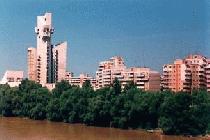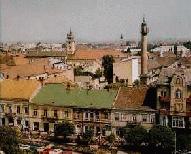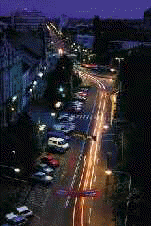 The Satu
Mare county lies in the North-West of Romania, on the
lower course of the Somes river, bordering the
Ukraine in the North, Hungary in the West and
the counties of Bihor, Salaj and Maramures in the South and East.The county has
a total area of 4405 square kilometers, representing 1.85% of the national
territory and ranks 36th among the other counties in this respect. From the
plains in the western part of the county, crossed by the rivers Somes, Tur and
Crasna, the relief gradually climbs towards the Oas and Gutâi mountains in the
East, the Pietroasa peak reaching 1,200 m.The climate is temperate, with hot
summers, cold winters and rich precipitations.
The Satu
Mare county lies in the North-West of Romania, on the
lower course of the Somes river, bordering the
Ukraine in the North, Hungary in the West and
the counties of Bihor, Salaj and Maramures in the South and East.The county has
a total area of 4405 square kilometers, representing 1.85% of the national
territory and ranks 36th among the other counties in this respect. From the
plains in the western part of the county, crossed by the rivers Somes, Tur and
Crasna, the relief gradually climbs towards the Oas and Gutâi mountains in the
East, the Pietroasa peak reaching 1,200 m.The climate is temperate, with hot
summers, cold winters and rich precipitations.
In June 1996, the county had a population of 395,014 inhabitants, of which 183,845 lived in the four cities: Satu Mare (130,729), Carei (26,224), Negresti Oas (16,539) and Tasnad (10,353). The structure of nationalities is Romanians (58.5%), Hungarians (35.0%), Germans (3.6%), Gypsies (2.5%) and others (0.4%). As far as cultural life is concerned, the Satu Mare county has quite rich traditions and an institutional network consisting of theatres, a philharmonic orchestra, 60 public libraries with over 1,000,000 books, 3 cinema halls, four multi-functional culture houses, 17 museums (including one dedicated to the preservation of the German population's traditions), two art galleries and an art promotion center. Mass media are also well represented by three daily newspapers, two literary magazines, two radio and one TV station. One in five inhabitants is engaged in the educational system which includes 269 kindergartens, 268 schools and 27 highschools, 14 vocational schools and 8 technical schools. Higher education is represented by a section of the Babes-Bolyai University in Cluj, as well as one of the Vasile Goldis University in Arad. Mention should be made here of the fact that 12,852 school-pupils, 2,169 highschool-pupils and 40 students study in Hungarian and German.
In the urbanization process Satu Mare has
undergone, significant changes have occurred especially  during the
XIXth century. Between 1768 - 1772, the old City Hall was
built in the baroque style, with a tower on the main facade. Among the most
representative buildings for that period one should mention that which nowadays
houses the art section of the County Museum,
having two wings with different architectural styles. In 1789, Earl Vecsey
bought the building a wing of which still stands as the oldest civil edifice in
town, while in 1842 the now existing neo-gothic building was erected. Situated
close to the Vecsey House, the Roman-Catholic Cathedral
occupies a central position in the Liberty Square. It has been
built between 1785 - 1798 and extended in 1937, during Bishop Ham Janos's term.
Built in the neo-classic style, it has a monumental portal with an Attic
frontispiece supported by six columns with Corinthian capitals. In the close
vicinity of the Cathedral stands the Bishop's Palace, an architectural monument
dating back to the first half of the XIXth century, built in the neo-classic
style after the plans of the Würzburg architect Iosif Bitthamer. Another
beautiful neo-classic construction dating back to the beginning of the XIXth
century is The Ormos House, situated in the Liberty Square. Considered by both
local people and tourists as particularly representative, the Dacia Hotel is at
the same time one of the most beautiful secession style buildings in
Transsilvania. It was erected in 1902 after a plan that had won the first prize
at the architecture contest in Vienna. Floral motifs made of enameled ceramics
are predominant on the expressive facade where the city coat of arms is also
placed, while the roof in two hues of blue confers the building a special
distinction. Situated also in the Liberty Square, "The White
House" has got its name due to the aspect of the
facade. It has been built between 1911 - 1912 in the secession style by the
plans of Ede and Miklos Schneider, having as distinctive elements the white
ceramic tiles on which medallions with floral motifs come into relief. Close
nearby stands The Shoemakers' House, first erected in 1830, but undergoing
radical transformations of the main facade and upper floor at the beginning of
the XXth century, so that now the building has an eclectic look. A significant
monument for the XVIIIth century architecture is the Reformed Church,
built over a period of 19 years after the baroque architectural concept of
Sigismund Preinlich. Well-known cultural institution, "The North
Theatre" is housed in a building erected in 1889
in the neo-classic style; two or three shows a week used to run here in the 800
seats hall between the two World Wars. The monumental Saint Archangels Michael and
Gabriel Orthodox Cathedral on December 1st 1918 has been built
between 1932 - 1937. The blueprints belong to the architects Victor Smigelschi
and G. P. Liteanu, while the style is inspired from the traditional Romanian
architecture, with a central dome and two lateral towers with loggias.The old City Prefecture
building on Vasile Lucaciu Street was erected in 1936 after the plans of G.P.
Liteanu, in the manner of the Romanian architecture school of the fourth decade.
The edifice gains
during the
XIXth century. Between 1768 - 1772, the old City Hall was
built in the baroque style, with a tower on the main facade. Among the most
representative buildings for that period one should mention that which nowadays
houses the art section of the County Museum,
having two wings with different architectural styles. In 1789, Earl Vecsey
bought the building a wing of which still stands as the oldest civil edifice in
town, while in 1842 the now existing neo-gothic building was erected. Situated
close to the Vecsey House, the Roman-Catholic Cathedral
occupies a central position in the Liberty Square. It has been
built between 1785 - 1798 and extended in 1937, during Bishop Ham Janos's term.
Built in the neo-classic style, it has a monumental portal with an Attic
frontispiece supported by six columns with Corinthian capitals. In the close
vicinity of the Cathedral stands the Bishop's Palace, an architectural monument
dating back to the first half of the XIXth century, built in the neo-classic
style after the plans of the Würzburg architect Iosif Bitthamer. Another
beautiful neo-classic construction dating back to the beginning of the XIXth
century is The Ormos House, situated in the Liberty Square. Considered by both
local people and tourists as particularly representative, the Dacia Hotel is at
the same time one of the most beautiful secession style buildings in
Transsilvania. It was erected in 1902 after a plan that had won the first prize
at the architecture contest in Vienna. Floral motifs made of enameled ceramics
are predominant on the expressive facade where the city coat of arms is also
placed, while the roof in two hues of blue confers the building a special
distinction. Situated also in the Liberty Square, "The White
House" has got its name due to the aspect of the
facade. It has been built between 1911 - 1912 in the secession style by the
plans of Ede and Miklos Schneider, having as distinctive elements the white
ceramic tiles on which medallions with floral motifs come into relief. Close
nearby stands The Shoemakers' House, first erected in 1830, but undergoing
radical transformations of the main facade and upper floor at the beginning of
the XXth century, so that now the building has an eclectic look. A significant
monument for the XVIIIth century architecture is the Reformed Church,
built over a period of 19 years after the baroque architectural concept of
Sigismund Preinlich. Well-known cultural institution, "The North
Theatre" is housed in a building erected in 1889
in the neo-classic style; two or three shows a week used to run here in the 800
seats hall between the two World Wars. The monumental Saint Archangels Michael and
Gabriel Orthodox Cathedral on December 1st 1918 has been built
between 1932 - 1937. The blueprints belong to the architects Victor Smigelschi
and G. P. Liteanu, while the style is inspired from the traditional Romanian
architecture, with a central dome and two lateral towers with loggias.The old City Prefecture
building on Vasile Lucaciu Street was erected in 1936 after the plans of G.P.
Liteanu, in the manner of the Romanian architecture school of the fourth decade.
The edifice gains  monumentality through the
five columns attached to the facade and houses today the Satu Mare County Museum
collections, divided into three sections: archeology, history and folk art. The
exhibited pieces are part of the national cultural heritage and constitute
eloquent proof of the history, civilization, material and spiritual culture
specific for the North-West of Romania. The County Museum also has three
libraries and a restoration laboratory.The art section of the County Museum in
the Liberty Square has over 3,000 plastic art pieces belonging to the most
representative Romanian artists, such as Nicolae Grigorescu, Dumitru Ghiata,
Henri Catargi, Corneliu Baba, Aurel Ciupe, Alexandru Ciucurencu, Ion Jalea, Ion
Irimescu, Paul Erdos etc. In 1969, a permanent exhibition of the Satu Mare
painter Aurel Popp was set up. . One should also mention the museums in Carei
and Tasnad, the Swabian one in Petresti, the Hungarian one in Bogdand, the
Mountain People Museum in Scarisoara, the Ady Endre and Vasile Lucaciu memorial
houses, the wooden church in Soconzel (a folk art monument), the Aloisie Tautu
memorial house in Valea Vinului, the Free Dacians' Reservation in Mediesu Aurit,
the archeological reservation in Bobald - Carei.
monumentality through the
five columns attached to the facade and houses today the Satu Mare County Museum
collections, divided into three sections: archeology, history and folk art. The
exhibited pieces are part of the national cultural heritage and constitute
eloquent proof of the history, civilization, material and spiritual culture
specific for the North-West of Romania. The County Museum also has three
libraries and a restoration laboratory.The art section of the County Museum in
the Liberty Square has over 3,000 plastic art pieces belonging to the most
representative Romanian artists, such as Nicolae Grigorescu, Dumitru Ghiata,
Henri Catargi, Corneliu Baba, Aurel Ciupe, Alexandru Ciucurencu, Ion Jalea, Ion
Irimescu, Paul Erdos etc. In 1969, a permanent exhibition of the Satu Mare
painter Aurel Popp was set up. . One should also mention the museums in Carei
and Tasnad, the Swabian one in Petresti, the Hungarian one in Bogdand, the
Mountain People Museum in Scarisoara, the Ady Endre and Vasile Lucaciu memorial
houses, the wooden church in Soconzel (a folk art monument), the Aloisie Tautu
memorial house in Valea Vinului, the Free Dacians' Reservation in Mediesu Aurit,
the archeological reservation in Bobald - Carei.
![]() For new pictures please click here!
For new pictures please click here!
[ About me | Acronyms
| CW | Data
Sheets | Docs | Download
| E-mail | HOME
| Ham projects | Hobby
circuits | Photo galery | PIC
| QTH
photos |
Sign
in my guestbook | View
my guestbook ]
© 2001 - YO5OFH, Csaba Gajdos